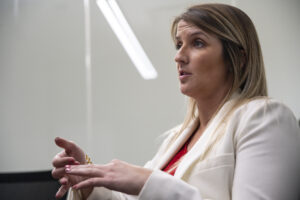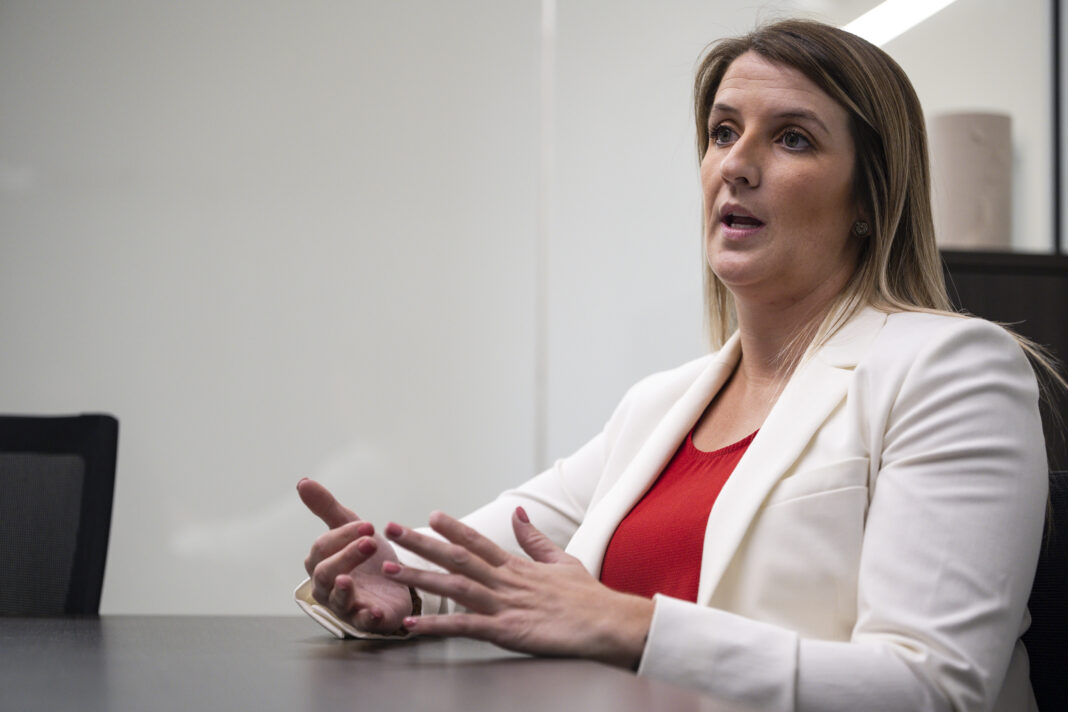Through the years, athletic training has become more than just taping sprained ankles on a football field.
Alanna Dennison, academic chair for the department of athletic training and interim coordinator for the kinesiology department at University of Texas Permian Basin, said they treat everyone from elite athletes to weekend warriors and people that enjoy gardening.
Dennison, who also is coordinator of clinical labs and an assistant professor, said athletic trainers can now be found in locations as different as physician’s offices, Amazon and the military. Located in the D. Kirk Edwards Family Human Performance Center, the program is part of the College of Health Sciences and Human Performance and includes nursing, social work and other fields.
There are certifications you can add, but an entry-level degree as an athletic trainer “really opens every door that you need it to,” Dennison said.
“There are just some things that can help you along the way in the unique areas. In Texas, Amazon is actually one of the biggest employers of athletic trainers. They have athletic trainers in most of their distribution facilities,” Dennison added.
In those facilities, the athletic trainers evaluate how people move when they’re working so they can look at the ergonomic set up of a work station and adjust that to accommodate how somebody is built, she said.

of the Athletic Training Department Alanna Dennison answers questions during an interview about careers within athletic training Thursday, Nov. 4, 2021, at the D. Kirk Edwards Family Human Performance Center. (Eli Hartman|Odessa American)
“So if they’re taller, if they’re shorter, how they stand, which hand is dominant, we can adjust workstations to allow for that,” Dennis said.
“We look at how people lift, how they do all of the tasks that are the high-risk tasks at work and we can keep people safe and healthy at work,” she added.
“… Now in a lot of places you’ll see a group of athletic trainers. Instead of having a PT (physical therapist) and PA (physician assistant) and an MD (medical doctor) and a strength and conditioning coach, you can have an athletic trainer that can fill all those roles; so it goes a lot deeper than just doing massage,” Dennison added.
Social work can help when athletes are transitioning from being in sports because they can offer ways to cope and help them look at career options. “The NFL is a prime example of hiring social workers to help individuals transition out of football …,” Dennison said.
In Texas, she said, there are two options for athletic training.
“We have licensure and we have certification. To become a certified athletic trainer, you have to go through a program that is accredited by the Commission on Accreditation of Athletic Training Education to become licensed. There are no requirements, essentially, for those programs except what is set out by the TDLR (Texas Department of Licensing and Regulation), so those are two separate entities if you will.
Texas is the only state that you can practice as an athletic trainer without being certified,” Dennison said. “So in the rest of the country you have to go through a CAATE-accredited program to practice. In Texas, you can go through what we call a licensure program and be able to practice. So those are both entry-level professional programs.”
“The CAATE programs have transitioned now to master’s level programs, or are in the process of transitioning to master’s level programs, and then we’re teaching out all of the undergraduate degrees. That is a difference we’re going to see in Texas. Now we’ll essentially have the bachelor’s programs for licensure and the master’s programs for certification.”
“With both of those degrees, you can work anywhere in the field as an athletic trainer …,” she added.

of the Athletic Training Department Alanna Dennison answers questions during an interview about careers within athletic training Thursday, Nov. 4, 2021, at the D. Kirk Edwards Family Human Performance Center. In addition to her positions at UTPB, Dennison is also a member of the Justin Boots Sports Medicine team that provides athletic training services to rodeo athletes as they compete in professional events across the United States. (Eli Hartman|Odessa American)
Dennison said a master’s degree has been proposed for UTPB.
“We are anticipating, fingers crossed, our first cohort in the summer of 2022 to seek accreditation,” she said.
There are 36 students in the bachelor’s program. This is the largest group they have had in some time.
“We have our biggest ever freshman cohort which is very exciting,” Dennison said.
The program was approved in spring of 2021 through the American Society of Orthopedic Professionals to offer a certification, or concentration program, that will allow students to work in a physician’s office.
Alondra Morales, a senior, will earn a degree in athletic training. The improving and up and coming nature of the program drew her in, along with the location.
Morales said she was involved in sports medicine at Midland High School.
“I did sports medicine my junior year and senior year of high school. Starting my junior year, I really fell in love with it and wanted to continue in it,” she said.
She said she was around sports and tried out for a number of them, but didn’t make it.
“It was the next thing and I’ve always been a helper and wanting to help people get better so that’s what drew me into athletic training,” Morales said.
Senior Megan Pennington said athletic training is a “very good step by step program that really helps you put it all together.”
Like Morales, Pennington was involved in sports medicine at home in El Paso.
She said her roommate, who she also went to high school with, introduced her to athletic training.
The program has integrated other aspects of the curriculum into athletic training “I think it’s really good. I think it’s really cool that we have our own building/college because we all work together so closely, especially the nurses and athletic trainers,” Pennington said.
She was drawn to athletic training after sustaining a shoulder injury in high school.
“I had to get surgery for it and when I went to the athletic trainers in high school, I was like this is so cool. They get to tape. They don’t have to sit down all the time because my biggest fear is having a computer job and if you watch me in class I can never sit still, so this job was very diverse and quick. It challenges me,” Pennington added.




